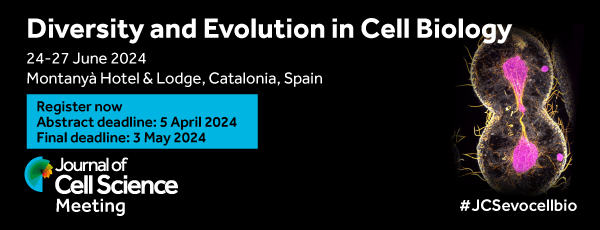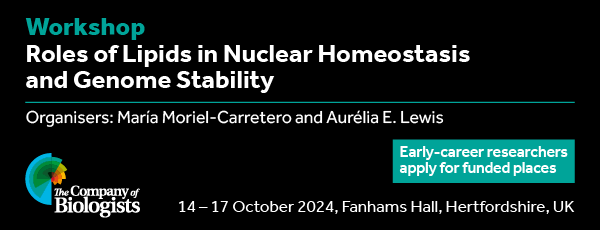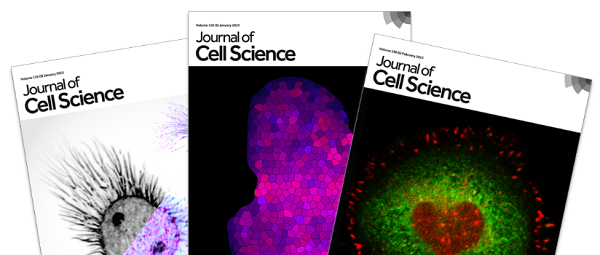Issues
-
Cover image
Cover Image

Cover: Three-dimensional reconstruction of an endometrial organoid infected with GFP-expressing Chlamydia trachomatis (magenta), immunostained for the Golgi complex (GM130, yellow) and imaged using Airyscan confocal microscopy. The Golgi complex is recruited to and fragmented around the Chlamydia-containing vacuole by type III secreted effectors. Nuclei (cyan) are stained with Hoechst. See article by L. Dolat and R. H. Valdivia (jcs252403).
- PDF Icon PDF LinkTable of contents
- PDF Icon PDF LinkIssue info
Special Issue: Cell Biology of Host-Pathogen Interactions
FIRST PERSON
CELL SCIENTISTS TO WATCH
CELL SCIENCE AT A GLANCE
Malaria parasite egress at a glance
Summary: Malaria parasite egress from its host cell is a key step in the life cycle of this important pathogen. The article summarises current knowledge of malarial egress and highlights major questions in the field.
REVIEWS
Mixed signals – how Trypanosoma cruzi exploits host-cell communication and signaling to establish infection
Summary:Trypanosoma cruzi, the causative agent of Chagas disease, subverts cell signaling mechanisms to survive in the host. Here, we explain the various cellular mechanisms that T. cruzi hijacks.
Picornavirus 3C – a protease ensuring virus replication and subverting host responses
Summary: This Review focuses on the structure of 3C and the molecular mechanisms through which it executes both viral and host physiological processes.
Viral use and subversion of membrane organization and trafficking
Summary: This Review at the intersection of membrane trafficking and virology discusses how viruses hijack the organisation and function of cellular membranes to accomplish their replication, assembly and egress.
Imaging host–pathogen interactions using epithelial and bacterial cell infection models
Summary: This Review discusses the selection and use of various epithelial cell culture methods and microscopy techniques that can be used to image host–pathogen interactions in vitro.
Cellular metabolism in the defense against microbes
Summary: This Review highlights diverse strategies through which cellular metabolic processes are rewired to execute defense against microbes.
The diverse roles and dynamic rearrangement of vimentin during viral infection
Summary: A review on the versatile regulations of vimentin in the key steps during the infection of various viruses, including binding, entry, trafficking, replication, assembly, and egress.
Emerging roles of non-coding RNAs in vector-borne infections
Summary: A review on the important role of non-coding RNAs in the interaction between vertebrate host cells, arthropod vectors and vector-borne pathogens.
Vacuolar escape of foodborne bacterial pathogens
Summary: A review of common mechanisms of how intracellular pathogens escape from the lumen of vacuoles in infected host cells. A new mechanism based on oxidation of vacuolar membranes is proposed.
SHORT REPORTS
Turgor-dependent and coronin-mediated F-actin dynamics drive septin disc-to-ring remodeling in the blast fungus Magnaporthe oryzae
Summary: Remodeling of incipient septin structures within fungal infection cells requires the pressure-dependent formation of a contractile F-actin ring and is promoted by the actin-modulating protein coronin.
Unc-13 homolog D mediates an antiviral effect of the chromosome 19 microRNA cluster miR-517a
Summary: The placenta-specific microRNA miR-517a attenuates viral infection. Here we have identified that miR-517a directly targets UNC13D as a part of its antiviral function.
Dynamic imaging reveals surface exposure of virulent Leishmania amastigotes during pyroptosis of infected macrophages
Summary: High-content real-time imaging of L. amazonensis-infected pyroptotic macrophages reveals surface exposure of virulent amastigotes that are retained through attachment to the parasitophorous vacuole membrane.
RESEARCH ARTICLES
Characterization of the novel mitochondrial genome segregation factor TAP110 in Trypanosoma brucei
Summary: TAP110 is a novel mitochondrial genome segregation factor in Trypanosoma brucei that associates with the previously described TAC component TAC102. Ultrastructure expansion microscopy reveals its proximal position to the kDNA.
Requirement of CRAMP for mouse macrophages to eliminate phagocytosed E. coli through an autophagy pathway
Summary: CRAMP is a critical component in autophagy-mediated clearance of phagocytosed E. coli by mouse macrophages.
Human microsporidian pathogen Encephalitozoon intestinalis impinges on enterocyte membrane trafficking and signaling
Summary: Characterization of the molecular and ultrastructural pathological effects of Encephalitozoon intestinalis infection in human intestinal epithelial cells.
Neonatal low-density granulocytes internalize and kill bacteria but suppress monocyte function using extracellular DNA
Summary: Interactions between human neonatal low-density granulocytes and bacteria drive production of extracellular DNA that impairs clearance of bacteria by monocytes and may compromise protective immunity.
Jagged–Notch-mediated divergence of immune cell crosstalk maintains the anti-inflammatory response in visceral leishmaniasis
Summary:Leishmania donovani redirects macrophage–T cell crosstalk to maintain anti-inflammatory cytokine response via the Jagged–Notch signaling pathway, resulting in immunosuppression during experimental visceral leishmaniasis.
Human-specific staphylococcal virulence factors enhance pathogenicity in a humanised zebrafish C5a receptor model
Summary: Development of a novel, enhanced Staphylococcus aureus infection model through humanisation of zebrafish enabled us to show the important contribution of S. aureus virulence factors PVL and HlgCB to infection.
BPIFB3 interacts with ARFGAP1 and TMED9 to regulate non-canonical autophagy and RNA virus infection
Summary: BPIFB3 is a regulator of a non-canonical cellular autophagy pathway that impacts the replication of enteroviruses and flaviviruses. Here, we define ARFGAP1 and TMED9 as essential components of this pathway.
Vibrio cholerae cytotoxin MakA induces noncanonical autophagy resulting in the spatial inhibition of canonical autophagy
Summary: Analysis of the interaction between MakA and mammalian host cells reveals that the Vibrio cholerae cytotoxin MakA induces endolysosomal aggregate formation in host cells to modulate autophagy.
FIB-SEM-based analysis of Borrelia intracellular processing by human macrophages
Summary: Interaction of borreliae with human macrophages is visualized by high-resolution tomography, revealing the contribution of membrane tunnels, phagosomes and ER to intracellular processing of spirochetes.
CMV-encoded GPCR pUL33 activates CREB and facilitates its recruitment to the MIE locus for efficient viral reactivation
Summary: The mechanisms dictating CMV reactivation from latency are incompletely understood. Here, we show the viral-encoded GPCR pUL33 is involved in CREB activation, thus aiding in successful reactivation.
Endophilin-A2-dependent tubular endocytosis promotes plasma membrane repair and parasite invasion
Summary: Crosstalk between endophilin-A2 and caveolin-1, proteins implicated in clathrin-independent endocytosis, regulates a tubular endocytic pathway important for plasma membrane repair and trypanosome invasion.
M. tuberculosis infection of human iPSC-derived macrophages reveals complex membrane dynamics during xenophagy evasion
Summary: Following phagosome membrane damage, Mycobacterium tuberculosis induces the formation of, and escapes from, tubulovesicular autophagosomes in human induced pluripotent stem cell-derived macrophages.
Cell-to-cell and genome-to-genome variability of adenovirus transcription tuned by the cell cycle
Summary: Single-cell and single-transcript analyses indicate that the cell cycle state at the time of infection tunes the cell-to-cell variability of immediate early gene transcription of human adenovirus.
Foot-and-mouth disease virus induces PERK-mediated autophagy to suppress the antiviral interferon response
Summary: Foot-and-mouth disease virus infection induces ER stress and the PERK-mediated UPR, which activates autophagic flux to promote virus multiplication by affecting antiviral interferon production.
Proteomic and mechanistic dissection of the poxvirus-customized ribosome
Summary: Through ribosome isolation and mass spectrometry approaches, we characterize novel modifications to ribosomal proteins during poxvirus infection.
Real-time dynamics of Plasmodium NDC80 reveals unusual modes of chromosome segregation during parasite proliferation
Summary: Dynamic localisation of the NDC80 protein complex, a kinetochore marker, during proliferative stages of the malaria parasite life cycle reveals unique modes of chromosome segregation.
Protein tyrosine phosphatase 1B is involved in efficient type I interferon secretion upon viral infection
Summary: PTP1B specifically promotes the secretion of type I IFNs independently of its phosphatase activity, but requiring its proper localization to the ER membrane.
Convergent Met and voltage-gated Ca2+ channel signaling drives hypermigration of Toxoplasma-infected dendritic cells
Summary: The parasite T. gondii hijacks the Ras–Erk, Met and Ca2+ signaling machinery to control the migration of immune cells and promote its own dissemination.
A function of profilin in force generation during malaria parasite motility that is independent of actin binding
Summary: Biochemical, computational, reverse genetic and biophysical approaches show that a divergent motif of profilin has a role in Plasmodium sporozoite migration, which is important for malaria transmission.
TOOLS AND RESOURCES
An endometrial organoid model of interactions between Chlamydia and epithelial and immune cells
Summary: 3D endometrial organoids are used to model Chlamydia infection and the role of secreted virulence factors in reprogramming host epithelial cells and immune cell recruitment.
Journal of Cell Science - more than just a journal

People who know JCS well will know that we're more than just a journal and that our community – the cell biology community – really is at the heart of everything we do. Read the full Editorial by Editor-in-Chief Michael Way and Executive Editor Seema Grewal.
2024 Journal Meeting 'Diversity and Evolution in Cell Biology'

Registration is open for our 2024 Journal Meeting Diversity and Evolution in Cell Biology, which aims to bring together evolutionary biologists and cell biologists investigating diverse aspects of cellular physiology. Submit your abstract by 5 April. Final registration deadline: 3 May 2024.
Workshop: Roles of Lipids in Nuclear Homeostasis and Genome Stability

Early-career researchers interested in the roles of nuclear lipids, apply now for one of the ten funded places at this Workshop, which will take place 14-17 October 2024. Application deadline: 19 April.
Reasons to submit to Journal of Cell Science

There are many benefits to publishing in Journal of Cell Science - read more about why you should choose JCS or visit our submission page now.



